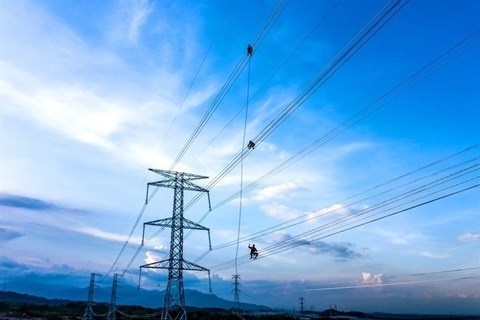Electricity purchases from Laos expanded to avert shortages
 |
| Electricity purchases from Laos expanded to avert shortages. Photo: VNA |
At the meeting of the Government Office on the implementation of key projects of state-run Electricity of Vietnam (EVN) a fortnight ago, Prime Minister Pham Minh Chinh requested the group to “absolutely not let power shortages happen”.
According to calculations by the Ministry of Industry and Trade (MoIT), the electricity shortage was estimated at 3.7 billion kWh in 2021, which increased to nearly 10 billion kWh in 2022. The most stressful time is currently expected in 2023, when the shortfall could reach about 15 billion kWh, before gradually decreasing to seven and 3.5 billion kWh in the years 2024 and 2025, respectively.
Extreme weather has rendered the assurance of electricity supply beyond the capacity of EVN as shortages of peaked in the north in May-July when the heat of the dry season combined with the output decline of hydroelectric power plants.
With the current proportion, new power sources expected to be completed annually in the next few years are calculated to always be lower than the growth in grid load.
EVN expects that by 2025, Vietnam will buy electricity from Laos with a minimum of 3,000MW, increasing to 5,000MW by 2030, following the commitment between the two governments, in which power plants in Laos will sell electricity directly to EVN’s grid.
To increase the capacity and buy electricity from Laos, EVN is accelerating all related processes. In August, the Nam Mo 220 kV transmission line project between Laos and Tuong Duong area with a length of 74.4km will be put into operation, synchronised with the cluster of the Nam Mo hydropower plant. The line will contribute to ensuring electricity supply to Vietnam’s northern region of in the coming years, as well as investment efficiency for both sides.
The government has approved 89 per cent of the committed capacity to buy electricity from Laos by 2025, and both sides have signed a power purchase agreement (PPA) until 2025.
According to the MoIT, EVN has signed 18 PPAs from 23 projects in Laos. Meanwhile, Phongsubthavy Group signed a number of power supply contracts with EVN. Two power transmission line projects in Laos funded by the former company are also expected to be completed this year, ensuring electricity supply as committed. Meanwhile, Électricité du Laos is working on connecting the Laotian power grid with 27 connection points of Vietnam’s grid.
The promotion of electricity imports from Laos to Vietnam is being carried out urgently. However Tran Dinh Nhan, general director of EVN, remains concerned whether the electricity price bracket for hydroelectricity, thermal power, and wind power imports from Laos to Vietnam will remain valid until the end of 2025.
“A suitable policy is necessary for EVN to have peace of mind when buying electricity from Laos,” Nhan said. “The price calculation and the PPAs should be promulgated by the competent authority in a timely manner.”
Dr. Nguyen Manh Cuong from the MoIT’s Institute of Energy predicts that Vietnam will increasingly depend on imported energy. “However, the complicated procedures of the Vietnamese side, along with the low average electricity price, are a huge barrier for the import of electricity,” Cuong said.
Previously, Vietnam was importing electricity from Laos at a cheaper price than domestic production. In 2020, the average purchase price of electricity from Laos was around 6 US cents per kWh, as data from the National Assembly’s Economic Committee showed. In the same year, the cost of electricity domestic production was at almost 8 US cents per kWh, according to the MoIT. The ministry has not announced the cost of electricity production in 2021.
| In 2016, Vietnam and Lao signed an MoU on development of hydropower, connecting power grids, and importing electricity from Laos. The nations also signed an agreement on development of energy and mines in 2019. According to the draft Power Development Plan VIII, each year Vietnam will import about 700MW and 3.5 billion kWh of electricity. In the high-load scenario, an additional 1,000MW and 5.5 billion kWh per year can be purchased to compensate for about 1,000MW of gas thermal power in the north. |
What the stars mean:
★ Poor ★ ★ Promising ★★★ Good ★★★★ Very good ★★★★★ Exceptional
 Tag:
Tag:
Related Contents
Latest News
More News
- VAL inaugurates second production line to meet domestic animal feed demand (December 19, 2025 | 16:37)
- Sun Group pioneers urban tram system in Phu Quoc (December 19, 2025 | 15:00)
- Top 10 notable events of Vietnam’s industry and trade sector in 2025 (December 19, 2025 | 14:00)
- Seven major projects launched to drive Hanoi’s next growth phase (December 19, 2025 | 14:00)
- Rare, beautiful, sustainable: the mark of iconic real estate (December 19, 2025 | 08:00)
- Mondelez Kinh Do - a chapter of purpose-led leadership in Vietnam (December 18, 2025 | 09:44)
- VNPAY services receive the highest-level PCI DSS international security certificates for six consecutive years (December 17, 2025 | 23:47)
- F&N deepens investment in Vinamilk (December 17, 2025 | 09:00)
- Long-term capital seen as key hurdle to green growth (December 16, 2025 | 08:00)
- HDS Summit spotlights Vietnam’s rising role in regional supply chains (December 16, 2025 | 08:00)























 Mobile Version
Mobile Version